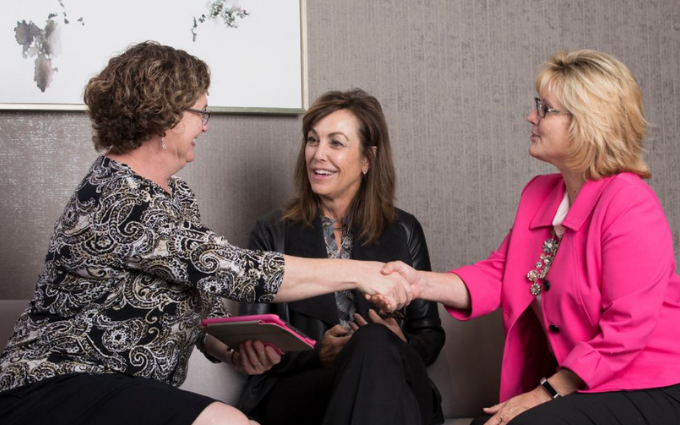05/07/2019

As we enter Nurses Week each year, it’s an occasion to reflect on goals and accomplishments, raise questions, and confirm our satisfaction in the roles we’ve chosen.
Why do catastrophic field case managers do what we do? Is it the long hours? Is it the tiring days in the car, to come back to the office and “document your day?” No. We do it because we love the challenge. And we value the opportunity to stand alongside wonderful people as they meet life’s most difficult challenges.
To care for a catastrophically injured person and their family, a field case manager holds the string connecting numerous specialists, an internist, and a Physical Medicine and Rehabilitation team. When that string begins to fray, we mend the weak spot and continue to link those providers.
Catastrophic injuries change the lives of those who are injured and those near to them. Being the first person on the scene in that neuro intensive care unit at the trauma center can be stimulating and frightening for all involved.
This first encounter with family/significant others is crucial. In 5 minutes or less, we must convince them we intend to advocate for their loved one and that our involvement is in their best interest.
We walk into the lives of the injured person’s family, who are wondering what is going to happen:
We use empathy in our approach and show sympathy for the situation, as we wonder how we’ll get our consent signed so we can gather medical information necessary to identify the case management plan and update key stakeholders.
We use terms such as workers’ compensation insurance and adjuster. We mention employers and other key stakeholders. We try to navigate the system and gain access to medical records and to lay eyes on that injured worker. In some cases, we delicately address difficult issues of compensability.
In this first encounter, we dig deep to lay the groundwork for a successful benign relationship with family/significant others. And once we have done that, we move on to the primary care team on the unit. Ideally, we are able to ask the internal case manager to assist in gaining access to information to allow us to update all parties regarding the injury status, treatment plan, and prognosis that has been established.
Sometimes we arrive so quickly, that only a portion of that information has been established. So we wait, gather, attempt to discuss the injured worker with inpatient physicians and nurses to establish those pieces of the puzzle.
Employers and carrier representatives ask for the most recent update even though we have spoken to them twice that day. The team anxiously awaits a comprehensive summary of events and clinical information as we rush back to the office to put it all in writing and send off those precious medical records.
This scenario describes a catastrophic field case manager’s first encounter with an injured worker, their family, and the medical providers caring for them. Similar activities continue on a daily basis, requiring ongoing onsite visits and multiple, multifaceted conversations.
This is not meant to paint a picture of perfection. There can be many bumps along the way, but catastrophic onsite case management drives each of us to overcome our inner fears and feelings and pursue all that we can to make the recovery of those we advocate for as successful as possible.
As we gather information in those initial days and weeks, we maintain contact with family/significant others to plan events unforeseen by them. This may include changes like discharge to a rehab facility, sometimes out of state, or discussion around what their homes look like and how their injured family member will navigate that environment.
Sometimes being proactive in this way is misconstrued as rushing the injured person out of the current care setting, when in reality we seek to address possible difficulties or delays later in their recovery. We share our thoughts and the expected course of recovery with the care team to gain their agreement and support in presenting those next steps to the family/significant others. These scenarios repeat themselves throughout the management of a case lasting many months to years.
The intense activities at the beginning of the relationship make all the difference for the long term. Many times we contact the injured worker’s spouse and family, just to see how they are holding up and we make sure we provide all that is required to the internal case manager and hospital treatment team.
Collaborating with all parties on expected next steps and inviting active participation when appropriate tells the family and others we are advocates. We truly ensure the best outcomes for their loved one.
Some say onsite case managers can be bulldogs in the field. Let’s call it passionate. We believe our knowledge and skills can make a difference in the outcome of a person’s injury rehabilitation and that managing those pieces in the right way, at the right time will achieve that success.
We provide education about the injuries to the family, injured worker, and all key stakeholders, to ensure everyone is reaching for a common goal.
It can be exhausting and satisfying at the same time. It can feel as if we are attempting to be successful in impossible circumstances, but we never quit. No, quitting is not an option.
The compassionate, professional relationships we develop with each injured worker provide insight and nurture the experience and knowledge to improve our work practices. Each interaction molds the work ethic and professionalism that sets a field catastrophic case manager apart from the rest.
So, we keep on keeping on. We know that our skill and service are very much needed and appreciated by those we serve.
I wish every one of Paradigm’s Network Managers a well-deserved, very Happy Nurses Week!
Want to learn more about our Network Managers’ Super Powers? Watch these videos submitted by Paradigm team members.